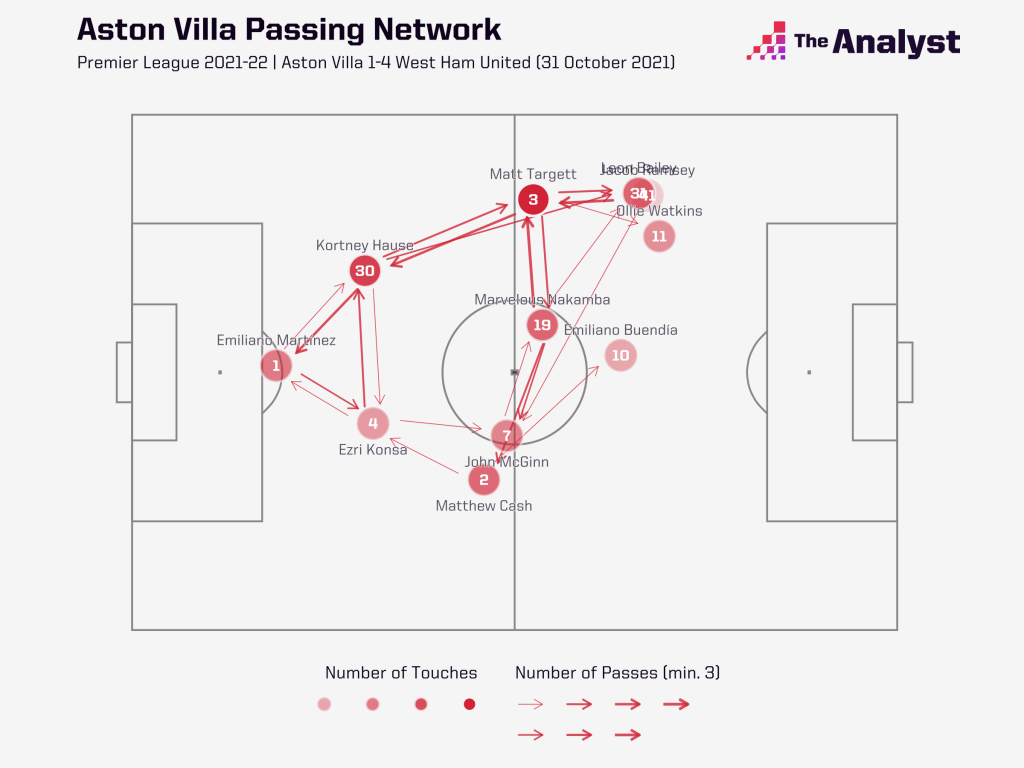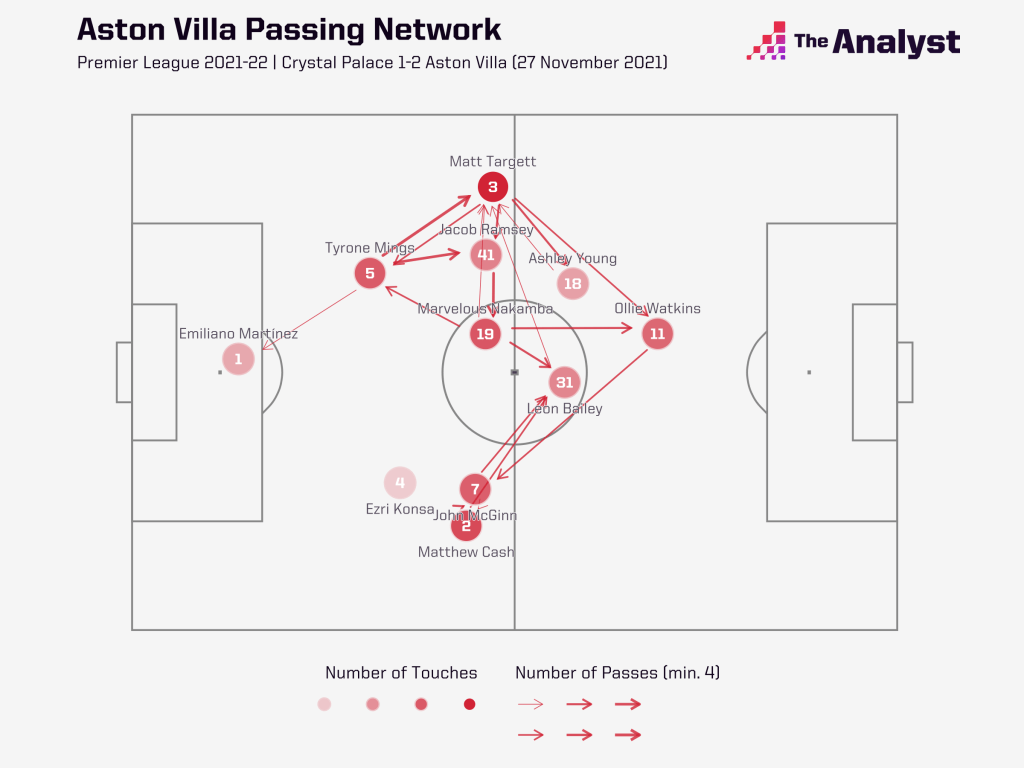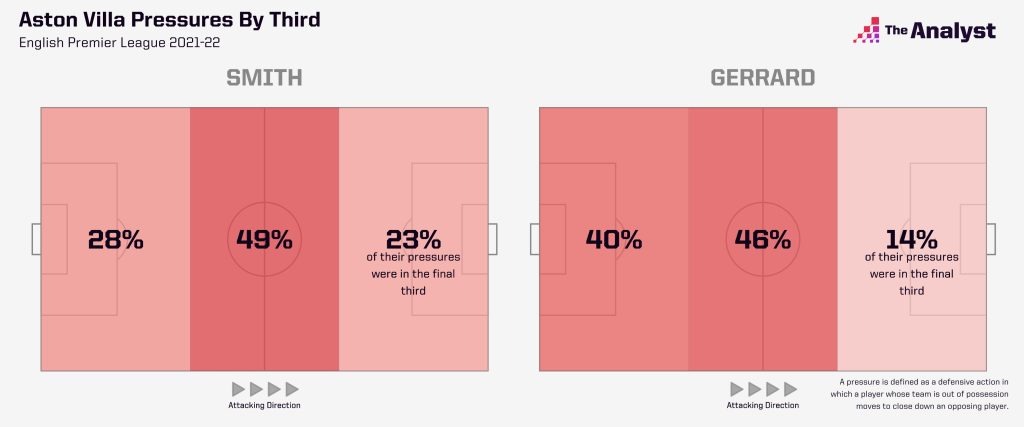The problem with attempting to decipher the reason for a ‘new manager bounce’ is that the tactical and psychological aspects of football are inextricably linked. An uptick in motivation and self-esteem invariably creates cohesion, shortening distances between players and increasing the intelligence of positional play and decision-making. The cause of this psychological improvement could simply be optimism at the dawn of a new era, or the new manager’s charisma.
On a basic level, Aston Villa have undoubtedly improved. Three wins from four games under Steven Gerrard has lifted them into the top ten and performances have been sharper, passing both the eye test and the data test as we highlight below. But before we look at the intricacies of Villa’s tactical development it’s important to note their expected goals (xG) total has gone from a 1.1 average per game under Dean Smith this season to 1.0 under Gerrard, and they are taking fewer shots, down from 11.7 to 10.3.
In the win over Brighton, Villa’s 0.52 xG was essentially matched by Brighton’s 0.53. And again, in the victory at Palace, their 0.88 xG was scarcely above the hosts’ 0.5. Villa just had that extra oomph, that special something, that curiously evasive ‘new manager bounce’.
Newfound Structure After Smith’s Broad Strokes
Nevertheless, there are clear patterns emerging that show Gerrard is changing the way Villa are playing for the better. Most notably, he and his team are introducing a level of structure, of tactical sophistication and intricate detail, that was lacking under Smith.
Stretching back to the start of the Smith era, too much focus was put on giving the ball to Jack Grealish and waiting for the magic to happen. Villa’s points-per-game league record in three years under Smith reads 1.52 with Grealish (123 points from 81 games) and 0.96 without (28 points from 29 games). That includes Villa’s promotion-winning Championship season when they collected 45 points in 19 games Grealish played under Smith and a shocking 16 in the 15 when he was absent.
Most of the time Villa’s players seemed to roam vaguely in the right areas but never with the sort of focus or cohesion that suggested things were choreographed in detail, with moves often involving aimless passing from side to side before a hoof down the pitch or, if possible, a hospital pass to Grealish to make something happen.
Under Gerrard it is immediately obvious that greater clarity is given to the players. They are holding positions with more symmetry with more consistent spaces between one another, while moves are built more evenly across the pitch and runs appear to be made as part of a collective, and taught, purpose. The following passing networks indicate as much. On the first, note Villa’s stretched disorder in a 4-1 defeat to West Ham, and on the second, see Villa’s tighter distribution and triangular options in the 2-1 win at Crystal Palace:


And as the graphics above point to, the basic principles under Gerrard are clear: A 4-3-2-1 formation in which the wingers come infield to play essentially as number tens (Ashley Young #18 and Leon Bailing #31 above); aggressive overlapping full backs to provide width; targeted pressing in the middle third of the pitch in particular; and neat possession football played vertically through the lines.
Off-the-Ball: Organised Pressing
Unlike in attack, there is no doubt Villa’s defence is improving. They are conceding 1.0 goals per game (down from 1.8), facing 10.8 shots per game (down from 14.5), and recording an average xGA of 0.8 (down from 1.4). Again, this could partly be a simple ‘new manager bounce’, given that Villa were previously performing well below their actual level. For starters, Tyrone Mings and Ezri Konsa are playing more like their old selves under Gerrard.

But there is a huge shift in how Villa press and where on the pitch they do it. Villa’s team presses have gone up under Gerrard from 21.4 per game to 27.5 per game, a number that would – stretched over the 15-game season to date – put Aston Villa top of the Premier League charts. Similarly, their average number of individual player pressures per game is up dramatically from 237.5 to 329.8, which would put Villa top of the table if achieved over the whole season so far.
In other words, right now Villa are now the most frequent pressers in the division.
However, Gerrard has not implemented a high press. Villa’s PPDA has risen from 13.7 to 17.5, suggesting they are happy to let the opposition have the ball before making a coordinated press. They maintain a compressed 4-3-2-1 shape while the opposition has it in their own third – before snapping into challenges in the middle third of the pitch. Villa’s average number of pressures per game has more than doubled in their own third (66.4 to 132.5), risen by roughly a third in the middle third (116.1 to 152.8) but gone down in the attacking third (55.1 to 44.5).
Comparing the proportion of their pressures under Smith to Gerrard points to this change of style. Villa’s proportion of pressures is way up in their own third and has fallen dramatically in the opposition third.

It is worth noting that while the data may be skewed by the fact one of Gerrard’s four games was against possession-hogging Manchester City, every one of his four matches has individually surpassed the highest pressure total recorded in a Smith game this season in the defensive and middle thirds.
Again, the shift in pressing style here is about control. Villa often looked disordered under Smith; they were too stretched to prevent the opponent from breaking through them, often pressing high in small groups that lacked the compression to actually be effective. By holding Villa slightly deeper, Gerrard’s team stay together and hunt in packs, making it much more difficult to reach Emi Martinez’s goal.
And they really do hunt. Villa’s tackling is up dramatically, from 14.1 to 21.5 per game. Had Villa been hitting a 21.5 average all season they would be the most frequent tacklers in the division, above current leaders Leeds United by almost two tackles per game.
On-the-Ball: Patient and Considered Possession
The shape under Gerrard and choreographed distribution of the ball is harder to capture in the data, beyond the passing networks above, although we can see that Villa are more measured in how they build their attacks since the manager change.
The accuracy of their on-the-ball actions suggest a more calculated approach. For example, while the team’s crossing rate is down from 14.7 to 9.5 per game the accuracy of their crossing has gone up from 18.2% to 27.3%. Villa know when to cross and when to recycle far better than they did under Smith when attacks could look a bit wild as they hurled balls into the box.
The same can be said of their shooting. Villa are taking more shots from inside the box (7.8 per game compared to 6.9) and fewer from outside (2.5 per game compared to 4.9), while their conversion rate is up significantly, from 10.9% to 17.1%. We know this latter statistic is explained by better shooting because Villa’s expected goals on target (xGOT) – measuring the post-shot xG, hence the quality of the strike – has risen from 1.0 to 1.3 per game. Greater efficiency, and shooting from more effective areas speaks to the sense of discipline, organisation, and tactical minutiae coached by Gerrard.
In terms of general build-up play, things are more about control, about less direct football. Villa’s number of 10+ open-play pass sequences has risen from 4.6 to 5.8 per game and the number of these moves that end in shots (known as ‘build-up attacks’) are up from 0.7 to 1.8.

On the flip side, not only is the dribbling rate down from 17.7 to 12.0 per game, but Villa’s ‘direct attacks’ (open-play sequences starting just inside the team’s own half that have at least 50% of movement towards the opposition’s goal and end in a shot or a touch in the opposition box) have dropped by from 1.7 to 0.8 per game.
Villa are more patient on the ball, most notably recycling the ball around the defence and base of midfield.
Aston Villa’s Next Steps
Interestingly, however, this is not true of every Villa player and indeed Gerrard probably wants his side to play with greater verticality through the lines in the weeks to come. John McGinn, who looks like an ideal Gerrard midfielder, has seen the number of opponents he bypasses with his passing go up from 39.0 to 61.2 per game. He is likely the archetype for other Villains to follow.
Ahead of him, in those dual number ten roles, we are yet to see the best of Emiliano Buendía or any of the other players trialled here, including Ashley Young, Leon Bailey, and Jacob Ramsey. This is the next big area of focus for Villa, who will look to funnel their attacks predominantly through these two playmakers, while Gerrard will also be expecting more from his flying full backs. At Rangers, James Tavernier and Borna Barišić contributed to 28 goals in the SPL last season.
Nevertheless, so far so good. Marvelous Nakamba is channelling N’Golo Kanté from the base of midfield, Ollie Watkins has rediscovered his goalscoring touch, and pretty much every Aston Villa player has improved to help the club win nine points from four games. The question, of course, is whether we are being presented with a mirage, a ‘new manager bounce’ masquerading as progress.
Judging by the data, and by the simple fact Villa already look and feel like Gerrard’s invincible Rangers, fans have every reason to assume this is the real deal.
Enjoy this? Subscribe to our mailing list to receive exclusive weekly content.
Design by Matt Sisneros.
